1. PT100 and PT1000 temperature resistance change table
Termiska motstånd av metall som nickel, koppar- och platinamotstånd har en positiv korrelation med förändringen i resistans med temperaturen. Platina har de mest stabila fysikaliska och kemiska egenskaperna och är den mest använda. Temperaturmätningsområdet för det vanliga platinamotståndet Pt100 är -200~850 ℃. Dessutom, temperaturmätningsområdena för Pt500, Pt1000, etc. successivt reduceras. Pt1000, temperaturmätningsområde -200~420 ℃. Enligt den internationella standarden IEC751, temperaturegenskaperna för platinamotståndet Pt1000 uppfyller följande krav:
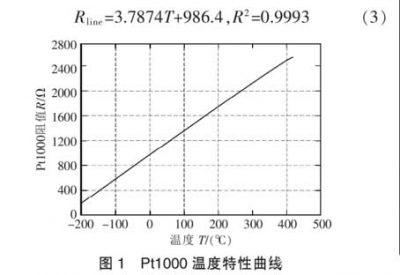
Pt1000 temperature characteristic curve
According to the Pt1000 temperature characteristic curve, the slope of the resistance characteristic curve changes little within the normal operating temperature range (som visas i figuren 1). Through linear fitting, the approximate relationship between resistance and temperature is:
1.1 PT100 temperature resistance change table
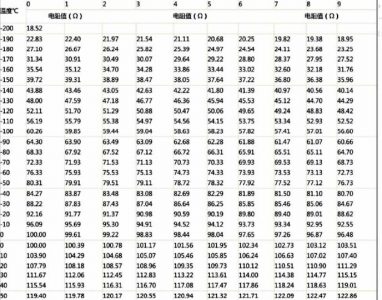
PT100 temperature resistance change table
1.2 PT1000 temperature resistance change table
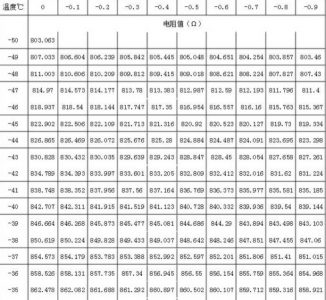
PT1000 Temperature Resistance Change Table
2. Commonly used acquisition circuit solutions
2.1 Resistor voltage division output 0~3.3V/3V analog voltage
Single-chip AD port direct acquisition
The temperature measurement circuit voltage output range is 0~3.3V, PT1000 (PT1000 resistance value changes greatly, temperature measurement sensitivity is higher than PT100; PT100 is more suitable for large-scale temperature measurement).
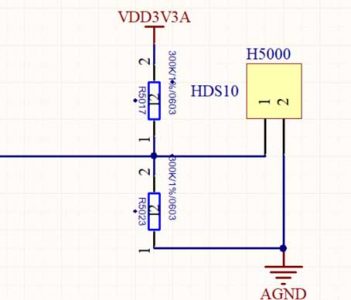
Motståndsspänningsavdelare utgångar 0 ~ 3.3V 3V analog spänning
Det enklaste sättet är att använda spänningsdelningsmetoden. Spänningen är spänningsreferenskällan 4V som genereras av TL431 -spänningsreferenschipet, eller Ref3140 kan användas för att generera 4.096V som referenskälla. Referenskällchips inkluderar också REF3120, 3125, 3130, 3133, och 3140. Chipet använder SOT-32-paket och 5V ingångsspänning. Utgångsspänningen kan väljas enligt den erforderliga referensspänningen. Naturligtvis, Enligt det normala spänningsingången för MCU -annonsen, det kan inte överstiga 3V/3.3V.
2.2 Motståndsspänningsdivision Output 0 ~ 5V Analog spänning MCU AD Port Direct Acquisition.
Naturligtvis, Vissa kretsar använder 5V MCU -strömförsörjning, och den maximala driftsströmmen för PT1000 är 0,5 mA, so appropriate resistance value should be used to ensure the normal operation of the components.
Till exempel, the 3.3V in the voltage division schematic diagram above is replaced with 5V. The advantage of this is that the 5V voltage division is more sensitive than 3.3V, and the acquisition is more accurate. Remember, the theoretical calculated output voltage cannot exceed +5V. Otherwise, it will cause damage to the MCU.
2.3 The most commonly used bridge measurement
R11, R12, R13 and Pt1000 are used to form a measuring bridge, where R11=R13=10k, R12=1000R precision resistors. When the resistance value of Pt1000 is not equal to the resistance value of R12, the bridge will output a mV-level voltage difference signal. This voltage difference signal is amplified by the instrument amplifier circuit and outputs the desired voltage signal. This signal can be directly connected to the AD conversion chip or the AD port of the microcontroller.
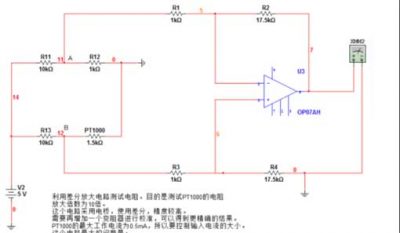
R11, R12, R13 and Pt1000 are used to form a measurement bridge
The principle of resistance measurement of this circuit:
1) PT1000 is a thermistor. När temperaturen ändras, the resistance changes basically linearly.
2) På 0 grader, the resistance of PT1000 is 1kΩ, then Ub and Ua are equal, som är, Uba = Ub – Ua = 0.
3) Assuming that at a certain temperature, the resistance of PT1000 is 1.5kΩ, then Ub and Ua are not equal. According to the voltage division principle, we can find out that Uba = Ub – Ua > 0.
4) OP07 is an operational amplifier, and its voltage gain A depends on the external circuit, where A = R2/R1 = 17.5.
5) The output voltage Uo of OP07 = Uba * A. So if we use a voltmeter to measure the output voltage of OP07, we can infer the value of Uab. Since Ua is a known value, we can further calculate the value of Ub. Sedan, using the voltage division principle, we can calculate the specific resistance value of PT1000. This process can be achieved through software calculation.
6) If we know the resistance value of PT1000 at any temperature, we only need to look up the table based on the resistance value to know the current temperature.
2.4 Constant current source
Due to the self-heating effect of the thermal resistor, the current flowing through the resistor should be as small as possible. I allmänhet, the current is expected to be less than 10mA. It has been verified that the self-heating of the platinum resistor PT100 of 1 mW will cause a temperature change of 0.02-0.75℃. Därför, reducing the current of the platinum resistor PT100 can also reduce its temperature change. Dock, if the current is too small, it is susceptible to noise interference, so the value is generally 0.5-2 mA, so the constant current source current is selected as a 1mA constant current source.
The chip is selected as the constant voltage source chip TL431, and then converted into a constant current source using current negative feedback. The circuit is shown in the figure
Bland dem, the operational amplifier CA3140 is used to improve the load capacity of the current source, and the calculation formula for the output current is:
The resistor should be a 0.1% precision resistor. The final output current is 0.996mA, som är, the accuracy is 0.4%.
Den konstanta strömkällkretsen bör ha följande egenskaper
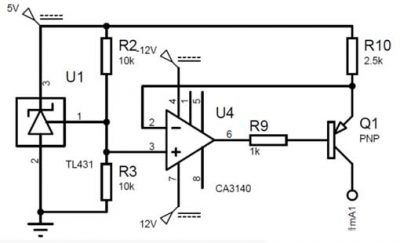
Välj konstant spänningskälla Chip TL431
Temperaturstabilitet: Eftersom vår temperaturmätningsmiljö är 0-100 ℃, Utgången från den nuvarande källan bör inte vara känslig för temperaturen. TL431 har en extremt låg temperaturkoefficient och låg temperaturdrift.
Bra belastningsreglering: Om den nuvarande krusningen är för stor, Det kommer att orsaka läsfel. Enligt teoretisk analys, Eftersom ingångsspänningen varierar mellan 100-138,5 mV, och temperaturmätningsområdet är 0-100 ℃, Temperaturmätningsnoggrannheten är ± 1 grad Celsius, så utgångsspänningen bör ändras med 38,5/100 = 0,385 mV för varje 1 ℃ Ökning av omgivningstemperatur. In order to ensure that the current fluctuation does not affect the accuracy, consider the most extreme case, på 100 grader Celsius, the resistance value of PT100 should be 138.5R. Then the current ripple should be less than 0.385/138.5=0.000278mA, som är, the current change during the load change should be less than 0.000278mA. In the actual simulation, the current source remains basically unchanged.
3. AD623 acquisition circuit solution
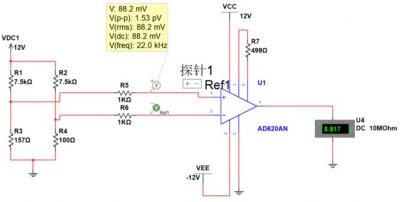
AD623 acquisition PT1000 circuit solution
The principle can refer to the above bridge measurement principle.
Low temperature acquisition:
High temperature acquisition
4. AD620 acquisition circuit solution
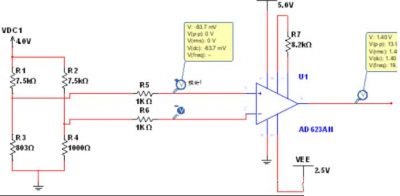
AD620 PT100 acquisition solution
AD620 PT100 acquisition solution high temperature (150°):
AD620 PT100 acquisition solution low temperature (-40°):
AD620 PT100 acquisition solution room temperature (20°):
5. PT100 and PT1000 anti-interference filtering analysis
Temperaturförvärv i något komplex, hårda eller speciella miljöer kommer att bli föremål för stor inblandning, främst inklusive EMI och REI.
Till exempel, Vid tillämpningen av motortemperaturförvärv, Motorstyrning och höghastighetsrotation av motoren orsakar högfrekventa störningar.
Det finns också ett stort antal temperaturkontrollscenarier inom flyg- och rymdfordon, som mäter och kontrollerar kraftsystemet och miljökontrollsystemet. Kärnan i temperaturkontrollen är temperaturmätning. Eftersom termistornas motstånd kan förändras linjärt med temperaturen, Att använda platinamotstånd för att mäta temperatur är en effektiv temperaturmätningsmetod med hög precision. De viktigaste problemen är följande:
1. Motståndet på ledtråden introduceras lätt, thus affecting the measurement accuracy of the sensor;
2. In some strong electromagnetic interference environments, the interference may be converted into DC output after rectification by the instrument amplifier
Offset error, affecting the measurement accuracy.
5.1 Aerospace airborne PT1000 acquisition circuit
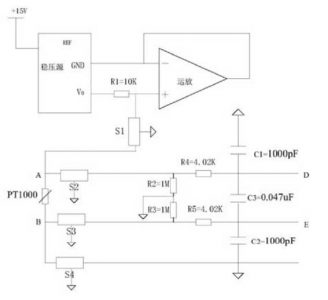
Aerospace airborne PT1000 acquisition circuit
Refer to the design of an airborne PT1000 acquisition circuit for anti-electromagnetic interference in a certain aviation.
A filter is set at the outermost end of the acquisition circuit. The PT1000 acquisition preprocessing circuit is suitable for anti-electromagnetic interference preprocessing of airborne electronic equipment interface;
The specific circuit is:
The +15V input voltage is converted into a +5V high-precision voltage source through a voltage regulator, och +5V högprecisionsspänningskällan är direkt ansluten till motståndet R1.
Den andra änden av motståndet R1 är uppdelat i två stigar, en ansluten till in-fas-ingången till OP-förstärkaren, och den andra ansluten till PT1000-motståndet ett slut genom T-typfiltret S1. Utgången från OP -förstärkaren är ansluten till inverterande ingången för att bilda en spänningsföljare, och inverteringsingången är ansluten till markporten för spänningsregulatorn för att säkerställa att spänningen vid in-fas-ingången alltid är noll. Efter att ha passerat S2 -filtret, I ena änden är ett av PT1000 -motståndet uppdelat i två stigar, En väg används som differentiell spänningsingång Terminal D genom motståndet R4, och den andra vägen är ansluten till AGND genom motstånd R2. After passing through the S3 filter, the other end B of the PT1000 resistor is divided into two paths, one path is used as the differential voltage input terminal E through resistor R5, and the other path is connected to AGND through resistor R3. D and E are connected through capacitor C3, D is connected to AGND through capacitor C1, and E is connected to AGND through capacitor C2; the precise resistance value of PT1000 can be calculated by measuring the differential voltage between D and E.
The +15V input voltage is converted into a +5V high-precision voltage source through a voltage regulator. The +5V is directly connected to R1. The other end of R1 is divided into two paths, one is connected to the in-phase input terminal of the op amp, and the other is connected to the PT1000 resistor A through the T-type filter S1. Utgången från OP -förstärkaren är ansluten till inverterande ingången för att bilda en spänningsföljare, och inverteringsingången är ansluten till markporten för spänningsregulatorn för att säkerställa att spänningen vid inverteringsingången alltid är noll. Just nu, Strömmen som strömmar genom R1 är en konstant 0,5 mA. Spänningsregulatorn använder AD586TQ/883B, och OP AMP använder OP467A.
Efter att ha passerat S2 -filtret, I ena änden är ett av PT1000 -motståndet uppdelat i två stigar, en genom motståndet R4 som differentiell spänningsingång, och en genom motståndet R2 till AGND; Efter att ha passerat S3 -filtret, the other end B of the PT1000 resistor is divided into two paths, en genom motståndet R5 som differentiell spänningsingång, och en genom motståndet R3 till AGND. D and E are connected through capacitor C3, D is connected to AGND through capacitor C1, and E is connected to AGND through capacitor C2.
Motståndet för R4 och R5 är 4,02K ohm, Motståndet för R1 och R2 är 1 m ohm, Kapacitansen för C1 och C2 är 1000pf, och kapacitansen för C3 är 0,047uf. R4, R5, C1, C2, och C3 bildar tillsammans ett RFI -filternätverk, som slutför lågpassfiltreringen av insignalen, och de objekt som ska filtreras ut inkluderar differentiellt läge -interferens och vanliga läge -interferens som bärs i ingångsdifferentialsignalen. Beräkningen av avgränsningsfrekvensen –3DB för den vanliga läge -interferensen och differentiellt läge som bärs i insignalen visas i formeln:
Ersätta motståndsvärdet i beräkningen, Common Mode Cutoff -frekvensen är 40 kHz, och avgränsningsfrekvensen för differentialläge är 2,6 kHz.
Slutpunkt B är ansluten till AGND genom S4 -filtret. Bland dem, Filter markterminaler från S1 till S4 är alla anslutna till flygplanets skärmplan. Eftersom strömmen flyter genom PT1000 är en känd 0,05 mA, the precise resistance value of PT1000 can be calculated by measuring the differential voltage at both ends of D and E.
S1 to S4 use T-type filters, model GTL2012X‑103T801, with a cutoff frequency of 1M±20%. This circuit introduces low-pass filters to the external interface lines and performs RFI filtering on the differential voltage. As a preprocessing circuit for PT1000, it effectively eliminates electromagnetic and RFI radiation interference, which greatly improves the reliability of the collected values. Dessutom, the voltage is directly measured from both ends of the PT1000 resistor, eliminating the error caused by the lead resistance and improving the accuracy of the resistance value.
5.2 T-type filter
The T-type filter consists of two inductors and capacitors. Both ends of it have high impedance, and its insertion loss performance is similar to that of the π-type filter, but it is not prone to “ringing” and can be used in switching circuits.
 English
English Afrikaans
Afrikaans العربية
العربية বাংলা
বাংলা bosanski jezik
bosanski jezik Български
Български Català
Català 粤语
粤语 中文(简体)
中文(简体) 中文(漢字)
中文(漢字) Hrvatski
Hrvatski Čeština
Čeština Nederlands
Nederlands Eesti keel
Eesti keel Suomi
Suomi Français
Français Deutsch
Deutsch Ελληνικά
Ελληνικά हिन्दी; हिंदी
हिन्दी; हिंदी Magyar
Magyar Bahasa Indonesia
Bahasa Indonesia Italiano
Italiano 日本語
日本語 한국어
한국어 Latviešu valoda
Latviešu valoda Lietuvių kalba
Lietuvių kalba македонски јазик
македонски јазик Bahasa Melayu
Bahasa Melayu Norsk
Norsk پارسی
پارسی Polski
Polski Português
Português Română
Română Русский
Русский Cрпски језик
Cрпски језик Slovenčina
Slovenčina Slovenščina
Slovenščina Español
Español Svenska
Svenska ภาษาไทย
ภาษาไทย Türkçe
Türkçe Українська
Українська اردو
اردو Tiếng Việt
Tiếng Việt
